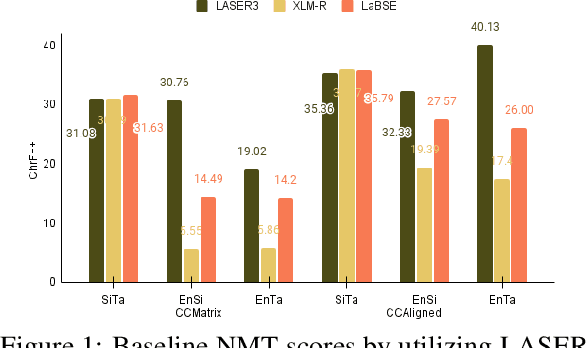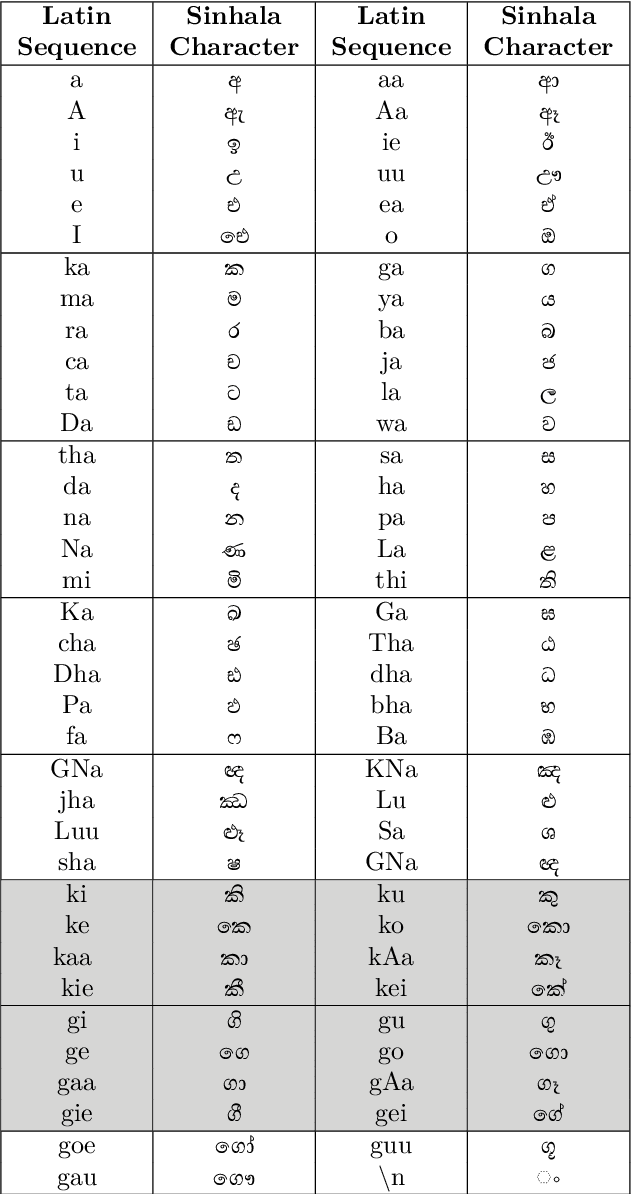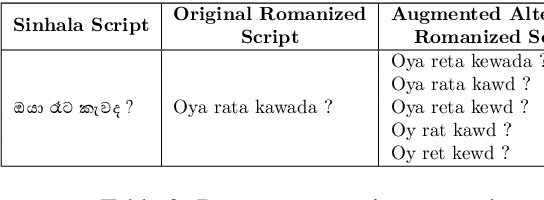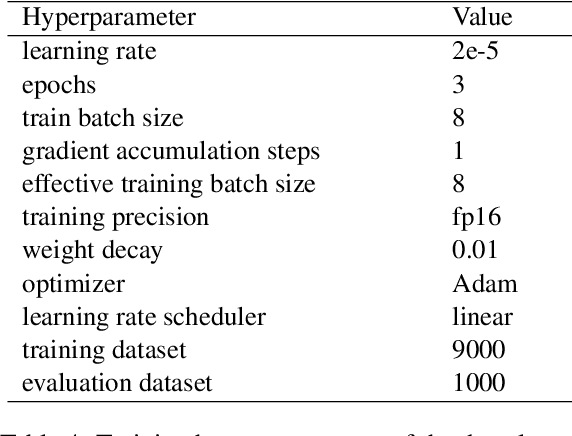Surangika Ranathunga
Hennie
SinLlama -- A Large Language Model for Sinhala
Aug 12, 2025Abstract:Low-resource languages such as Sinhala are often overlooked by open-source Large Language Models (LLMs). In this research, we extend an existing multilingual LLM (Llama-3-8B) to better serve Sinhala. We enhance the LLM tokenizer with Sinhala specific vocabulary and perform continual pre-training on a cleaned 10 million Sinhala corpus, resulting in the SinLlama model. This is the very first decoder-based open-source LLM with explicit Sinhala support. When SinLlama was instruction fine-tuned for three text classification tasks, it outperformed base and instruct variants of Llama-3-8B by a significant margin.
Utilizing Multilingual Encoders to Improve Large Language Models for Low-Resource Languages
Aug 12, 2025Abstract:Large Language Models (LLMs) excel in English, but their performance degrades significantly on low-resource languages (LRLs) due to English-centric training. While methods like LangBridge align LLMs with multilingual encoders such as the Massively Multilingual Text-to-Text Transfer Transformer (mT5), they typically use only the final encoder layer. We propose a novel architecture that fuses all intermediate layers, enriching the linguistic information passed to the LLM. Our approach features two strategies: (1) a Global Softmax weighting for overall layer importance, and (2) a Transformer Softmax model that learns token-specific weights. The fused representations are mapped into the LLM's embedding space, enabling it to process multilingual inputs. The model is trained only on English data, without using any parallel or multilingual data. Evaluated on XNLI, IndicXNLI, Sinhala News Classification, and Amazon Reviews, our Transformer Softmax model significantly outperforms the LangBridge baseline. We observe strong performance gains in LRLs, improving Sinhala classification accuracy from 71.66% to 75.86% and achieving clear improvements across Indic languages such as Tamil, Bengali, and Malayalam. These specific gains contribute to an overall boost in average XNLI accuracy from 70.36% to 71.50%. This approach offers a scalable, data-efficient path toward more capable and equitable multilingual LLMs.
Leveraging Synthetic Data for Question Answering with Multilingual LLMs in the Agricultural Domain
Jul 22, 2025



Abstract:Enabling farmers to access accurate agriculture-related information in their native languages in a timely manner is crucial for the success of the agriculture field. Although large language models (LLMs) can be used to implement Question Answering (QA) systems, simply using publicly available general-purpose LLMs in agriculture typically offer generic advisories, lacking precision in local and multilingual contexts due to insufficient domain-specific training and scarcity of high-quality, region-specific datasets. Our study addresses these limitations by generating multilingual synthetic agricultural datasets (English, Hindi, Punjabi) from agriculture-specific documents and fine-tuning language-specific LLMs. Our evaluation on curated multilingual datasets demonstrates significant improvements in factual accuracy, relevance, and agricultural consensus for the fine-tuned models compared to their baseline counterparts. These results highlight the efficacy of synthetic data-driven, language-specific fine-tuning as an effective strategy to improve the performance of LLMs in agriculture, especially in multilingual and low-resource settings. By enabling more accurate and localized agricultural advisory services, this study provides a meaningful step toward bridging the knowledge gap in AI-driven agricultural solutions for diverse linguistic communities.
Elementary Math Word Problem Generation using Large Language Models
Jun 06, 2025



Abstract:Mathematics is often perceived as a complex subject by students, leading to high failure rates in exams. To improve Mathematics skills, it is important to provide sample questions for students to practice problem-solving. Manually creating Math Word Problems (MWPs) is time consuming for tutors, because they have to type in natural language while adhering to grammar and spelling rules of the language. Existing Deep Learning techniques for MWP generation either require a tutor to provide the initial portion of the MWP, and/or additional information such as an equation. In this paper, we present an MWP generation system based on Large Language Models (LLMs) that overcome the need for additional input - the only input to our system is the number of MWPs needed, the grade and the type of question (e.g. addition, subtraction). Unlike the existing LLM-based solutions for MWP generation, we carried out an extensive set of experiments involving different LLMs, prompting strategies, techniques to improve the diversity of questions, as well as techniques that employ human feedback to improve LLM performance. Human and automated evaluations confirmed that the generated MWPs are high in quality, with minimal spelling and grammar issues. However, LLMs still struggle to generate questions that adhere to the specified grade and question type requirements.
Beyond Vanilla Fine-Tuning: Leveraging Multistage, Multilingual, and Domain-Specific Methods for Low-Resource Machine Translation
Mar 28, 2025



Abstract:Fine-tuning multilingual sequence-to-sequence large language models (msLLMs) has shown promise in developing neural machine translation (NMT) systems for low-resource languages (LRLs). However, conventional single-stage fine-tuning methods struggle in extremely low-resource NMT settings, where training data is very limited. This paper contributes to artificial intelligence by proposing two approaches for adapting msLLMs in these challenging scenarios: (1) continual pre-training (CPT), where the msLLM is further trained with domain-specific monolingual data to compensate for the under-representation of LRLs, and (2) intermediate task transfer learning (ITTL), a method that fine-tunes the msLLM with both in-domain and out-of-domain parallel data to enhance its translation capabilities across various domains and tasks. As an application in engineering, these methods are implemented in NMT systems for Sinhala, Tamil, and English (six language pairs) in domain-specific, extremely low-resource settings (datasets containing fewer than 100,000 samples). Our experiments reveal that these approaches enhance translation performance by an average of +1.47 bilingual evaluation understudy (BLEU) score compared to the standard single-stage fine-tuning baseline across all translation directions. Additionally, a multi-model ensemble further improves performance by an additional BLEU score.
A Framework to Assess Multilingual Vulnerabilities of LLMs
Mar 17, 2025



Abstract:Large Language Models (LLMs) are acquiring a wider range of capabilities, including understanding and responding in multiple languages. While they undergo safety training to prevent them from answering illegal questions, imbalances in training data and human evaluation resources can make these models more susceptible to attacks in low-resource languages (LRL). This paper proposes a framework to automatically assess the multilingual vulnerabilities of commonly used LLMs. Using our framework, we evaluated six LLMs across eight languages representing varying levels of resource availability. We validated the assessments generated by our automated framework through human evaluation in two languages, demonstrating that the framework's results align with human judgments in most cases. Our findings reveal vulnerabilities in LRL; however, these may pose minimal risk as they often stem from the model's poor performance, resulting in incoherent responses.
Improving the quality of Web-mined Parallel Corpora of Low-Resource Languages using Debiasing Heuristics
Feb 26, 2025



Abstract:Parallel Data Curation (PDC) techniques aim to filter out noisy parallel sentences from the web-mined corpora. Prior research has demonstrated that ranking sentence pairs using similarity scores on sentence embeddings derived from Pre-trained Multilingual Language Models (multiPLMs) and training the NMT systems with the top-ranked samples, produces superior NMT performance than when trained using the full dataset. However, previous research has shown that the choice of multiPLM significantly impacts the ranking quality. This paper investigates the reasons behind this disparity across multiPLMs. Using the web-mined corpora CCMatrix and CCAligned for En$\rightarrow$Si, En$\rightarrow$Ta and Si$\rightarrow$Ta, we show that different multiPLMs (LASER3, XLM-R, and LaBSE) are biased towards certain types of sentences, which allows noisy sentences to creep into the top-ranked samples. We show that by employing a series of heuristics, this noise can be removed to a certain extent. This results in improving the results of NMT systems trained with web-mined corpora and reduces the disparity across multiPLMs.
Linguistic Entity Masking to Improve Cross-Lingual Representation of Multilingual Language Models for Low-Resource Languages
Jan 10, 2025



Abstract:Multilingual Pre-trained Language models (multiPLMs), trained on the Masked Language Modelling (MLM) objective are commonly being used for cross-lingual tasks such as bitext mining. However, the performance of these models is still suboptimal for low-resource languages (LRLs). To improve the language representation of a given multiPLM, it is possible to further pre-train it. This is known as continual pre-training. Previous research has shown that continual pre-training with MLM and subsequently with Translation Language Modelling (TLM) improves the cross-lingual representation of multiPLMs. However, during masking, both MLM and TLM give equal weight to all tokens in the input sequence, irrespective of the linguistic properties of the tokens. In this paper, we introduce a novel masking strategy, Linguistic Entity Masking (LEM) to be used in the continual pre-training step to further improve the cross-lingual representations of existing multiPLMs. In contrast to MLM and TLM, LEM limits masking to the linguistic entity types nouns, verbs and named entities, which hold a higher prominence in a sentence. Secondly, we limit masking to a single token within the linguistic entity span thus keeping more context, whereas, in MLM and TLM, tokens are masked randomly. We evaluate the effectiveness of LEM using three downstream tasks, namely bitext mining, parallel data curation and code-mixed sentiment analysis using three low-resource language pairs English-Sinhala, English-Tamil, and Sinhala-Tamil. Experiment results show that continually pre-training a multiPLM with LEM outperforms a multiPLM continually pre-trained with MLM+TLM for all three tasks.
Sinhala Transliteration: A Comparative Analysis Between Rule-based and Seq2Seq Approaches
Dec 31, 2024



Abstract:Due to reasons of convenience and lack of tech literacy, transliteration (i.e., Romanizing native scripts instead of using localization tools) is eminently prevalent in the context of low-resource languages such as Sinhala, which have their own writing script. In this study, our focus is on Romanized Sinhala transliteration. We propose two methods to address this problem: Our baseline is a rule-based method, which is then compared against our second method where we approach the transliteration problem as a sequence-to-sequence task akin to the established Neural Machine Translation (NMT) task. For the latter, we propose a Transformer-based Encode-Decoder solution. We witnessed that the Transformer-based method could grab many ad-hoc patterns within the Romanized scripts compared to the rule-based method. The code base associated with this paper is available on GitHub - https://github.com/kasunw22/Sinhala-Transliterator/
Unsupervised Bilingual Lexicon Induction for Low Resource Languages
Dec 22, 2024Abstract:Bilingual lexicons play a crucial role in various Natural Language Processing tasks. However, many low-resource languages (LRLs) do not have such lexicons, and due to the same reason, cannot benefit from the supervised Bilingual Lexicon Induction (BLI) techniques. To address this, unsupervised BLI (UBLI) techniques were introduced. A prominent technique in this line is structure-based UBLI. It is an iterative method, where a seed lexicon, which is initially learned from monolingual embeddings is iteratively improved. There have been numerous improvements to this core idea, however they have been experimented with independently of each other. In this paper, we investigate whether using these techniques simultaneously would lead to equal gains. We use the unsupervised version of VecMap, a commonly used structure-based UBLI framework, and carry out a comprehensive set of experiments using the LRL pairs, English-Sinhala, English-Tamil, and English-Punjabi. These experiments helped us to identify the best combination of the extensions. We also release bilingual dictionaries for English-Sinhala and English-Punjabi.
 Add to Chrome
Add to Chrome Add to Firefox
Add to Firefox Add to Edge
Add to Edge